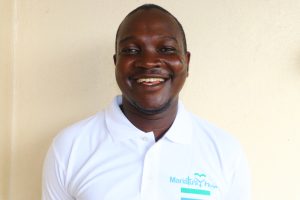In the remote community of Kambia Worreh, 128 people rely on a broken-down dug well that is overcrowded, unsafe, and unreliable. When that well runs dry, they are forced to go to a distant swamp and collect water that isn't safe to consume. This has been the norm for community members for twenty years. Many have never known life without a water crisis.

The primary water source - a dug well in poor condition.
Many community members have to walk more than 30 minutes one way to reach the swamp.
Field Officer Alimamy Lamin described their secondary water source: "The alternate source is bushy, and the grass grows close to the water and is not protected. The mere fact that the water point is not protected may lead to some negative health impacts. A person may have diarrhea, dysentery, and typhoid if he or she drinks water from that source."

The swamp where community members collect water when the well is dry or overcrowded.
14-year-old Mustapha has never known another way of life. He bravely shared how his community's water situation affects him.
"The distance to the water source makes me feel upset when I am sent to fetch water. The situation always becomes worse when I am tired and just from school."

Mustapha in the swamp.
"The frequent scarcity of water in our community impacts my time at school. When there is a water crisis, I go out of the community to search for water, and the distance to the different water sources always makes me too late to go to school. This affects my schooling activities, especially [in] the time of examinations. I will not have enough time for my studies, if I spend so much time to go and in search of water," he continued.
Even when their dug well hasn't run dry, its output is low, creating long lines that steal even more of Mustapha's time.
"Fetching may take so long due to the crowd and the distance to the water source. We fetch water one after the other; sometimes, the water source does not provide sufficient water. This is the reason why we spend so much time to get the quantity of water we need," he shared.
Mustapha worries for his and his community's safety when it comes to using the swamp.
"I am worried about the safety of [the] current water source because it is too far from the community. Something may happen to someone in that water source that is unknown to the community. The water source is isolated and bushy. It is hilly and difficult to access."

Mustapha carrying water from the swamp.
Rehabilitating their current dug well and converting it to a borehole well will give Mustapha a sense of peace, knowing he won't have to use the distant swamp. After its rehabilitation, the well will provide plenty of water and won't run dry, ensuring Mustapha has year-round access to safe water. For the first time, he can prioritize his education and his childhood, giving him the building blocks he needs to achieve his dreams.
Steps Toward a Solution
Our technical experts worked with the local community to identify the most effective solution to their water crisis. They decided to drill a borehole well, construct a platform for the well, and attach a hand pump.
Well
Abundant water often lies just beneath our feet. Aquifers—natural underground rivers—flow through layers of sediment and rock, offering a constant supply of safe water. A borehole well is drilled deep into the earth to access this naturally filtered and protected water. We penetrate meters, sometimes even hundreds of meters, of soil, silt, rock, and more to reach the water underground. Once found, we construct a platform for the well and attach a hand pump. The community gains a safe, enclosed water source capable of providing approximately five gallons of water per minute. Learn more here!
Community Education & Ownership
Hygiene and sanitation training are integral to our water projects. Training is tailored to each community's specific needs and includes key topics such as proper water handling, improved hygiene practices, disease transmission prevention, and care of the new water point. Safe water and improved hygiene habits foster a healthier future for everyone in the community. Encouraged and supported by the guidance of our team, a water user committee representative of the community's diverse members assumes responsibility for maintaining the water point, often gathering fees to ensure its upkeep.

 Borehole Well and Hand Pump
Borehole Well and Hand Pump

















